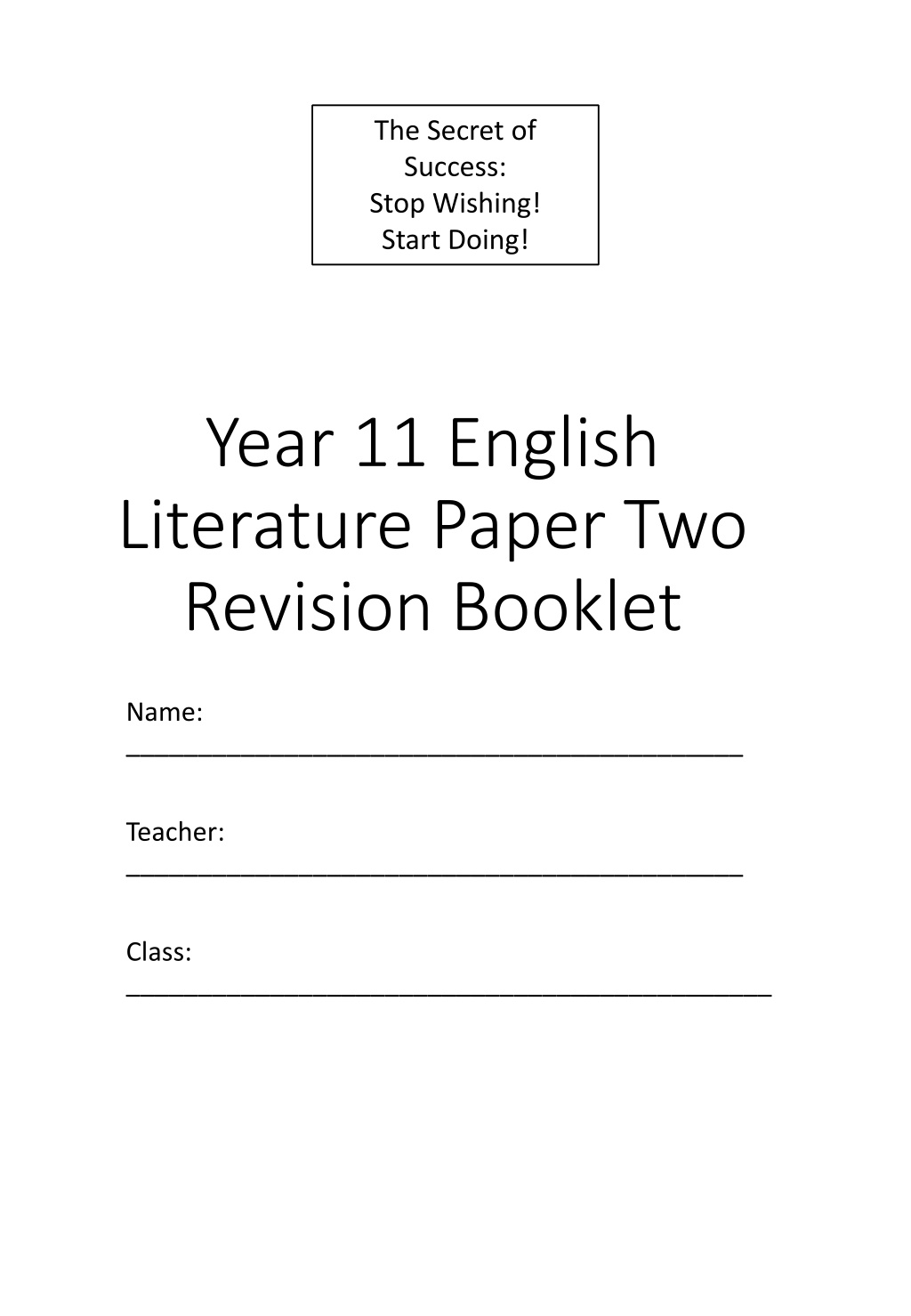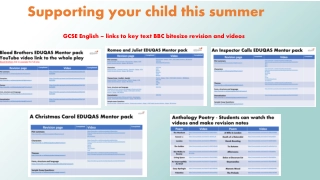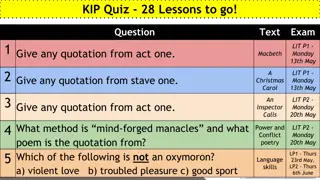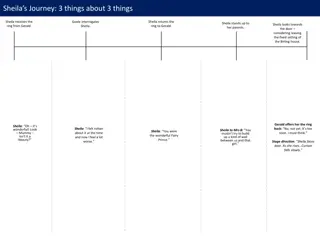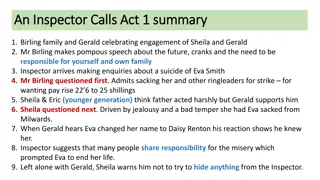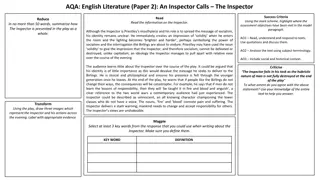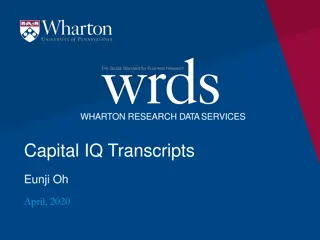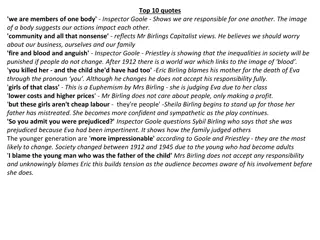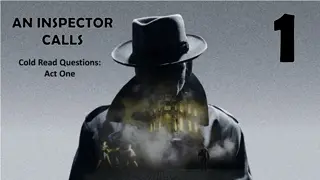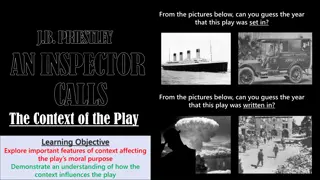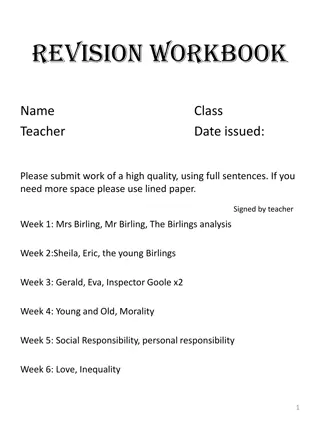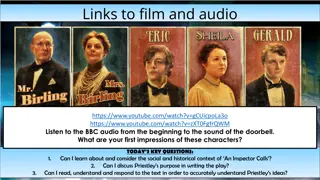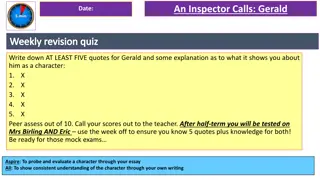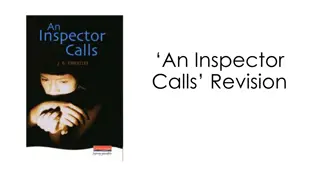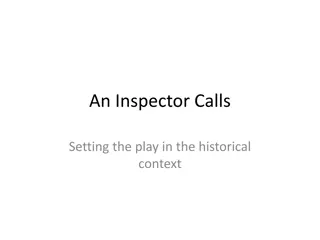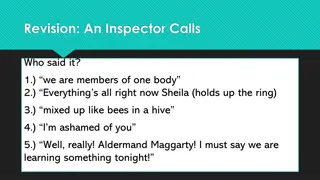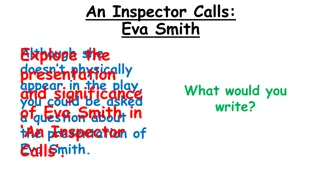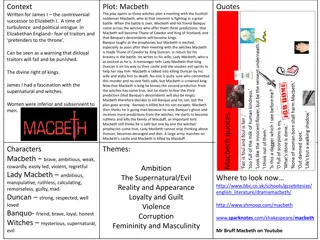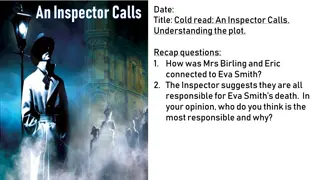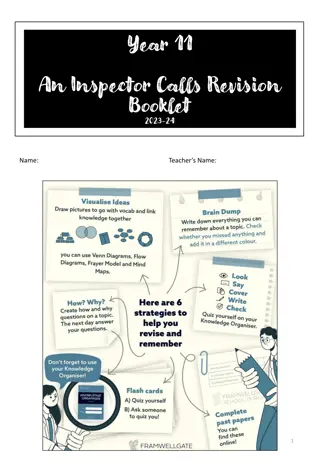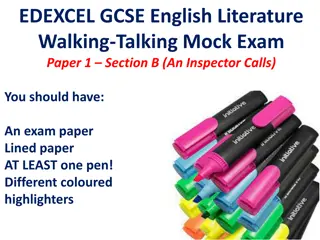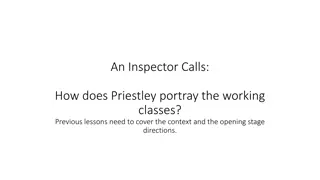Literature Exam Revision: An Inspector Calls Analysis
In this literature exam revision booklet focusing on "An Inspector Calls," students are guided through tasks like summarizing the play, creating mind maps on characters, themes, and more. It delves into the themes of social class, responsibility, morality, time, love, inequality, and deception depicted in the play, offering insights on how these elements intertwine with the characters and context. This resource provides a comprehensive approach to understanding and analyzing the play for exam preparation.
Download Presentation

Please find below an Image/Link to download the presentation.
The content on the website is provided AS IS for your information and personal use only. It may not be sold, licensed, or shared on other websites without obtaining consent from the author. Download presentation by click this link. If you encounter any issues during the download, it is possible that the publisher has removed the file from their server.
E N D
Presentation Transcript
The Secret of Success: Stop Wishing! Start Doing! Year 11 English Literature Paper Two Revision Booklet Name: ___________________________________________ Teacher: ___________________________________________ Class: _____________________________________________
What do your Literature Exams look like?
Paper One Tasks and Quotes Section A: An Inspector Calls Task One: Summarise what An Inspector Calls is about? ____________________________________________________________________________________ ____________________________________________________________________________________ ____________________________________________________________________________________ ____________________________________________________________________________________ Task Two: Make a mind map about what happens in each Act Challenge: Can you link each bullet point to context?
Task Three: Make mind maps about each of the characters Challenge: Can you add quotes to support your ideas and add how they link to Elizabethan context? Super Challenge: Can you make mind maps about any of the minor characters? Task Four: Make mind maps about each of the themes and how they are presented Challenge: Can you add how each character links to the theme? Social class and status: Priestley shows that class hierarchies need to change Social responsibility: the interrogation of each of the characters demonstrates the need for change Personal responsibility: Priestley advocates the need for individuals to accept responsibility for their own actions. It is because Arthur, Sybil and Gerald, shirk this responsibility that the phone rings again at the end of the play, thus warning the characters and audience that they must change their attitude. Morality: Priestley explores the idea of morality in terms of society, the behaviour of individuals and the treatment of others rather than in a religious sense. However, the seven deadly sins (pride, envy, gluttony, lust, anger, greed and sloth) are evident in the behaviour of the characters and Priestley clearly warns against them. Time: setting the play in 1912 allows Priestley to distance the audience from the action on stage whilst still teaching them a lesson about learning from mistakes. Priestley exploits the time setting of the play to shape our impression of Birlingthrough dramatic irony. Lines such as fire and blood and anguish make reference to the wars experienced by both Priestley and the contemporary audience. Love: the play begins with the engagement between Sheila and Gerald but Priestley suggests that their relationship is already adversely affected by money , business, gender inequality and deceit. Inequality: men/women (a patriarchal society leading to misogyny); class (upper and lower social classes are segregated. Money equals power (Capitalism and the focus on money rather than people). Lies, secrecy and deceit: Priestley suggests that the lives of the upper and middle classes are based on hypocrisy through his depiction of the Birling family.
Task Five: Make a mind map about context Challenge: Can you add how characters link to context? Super Challenge: Can you also add quotes that link to context? Can you add your own research about the context for An Inspector Calls into this box?
Task Six: Below are 20 quotes that you should try to remember from the play. Complete the look/cover/write/check for each quote Quote Look Cover Write Check Act One You re Squiffy Sheila to Eric For lower costs and higher prices Birling to family Burnt her inside out, of course Inspector to family Better to ask for the earth than to take it Inspector to Birling She was very pretty and looked as if she could take care of herself Sheila Act Two We often do on the young ones Inspector to Mrs Birling He s only a boy Mrs Birling to Inspector I became at once the most important thing in her life Gerald to Inspector A girl in her position Mrs Birling to the Inspector
Quote Look Cover Write Check I accept no blame for it at all Mrs Birling to Inspector Act Three I was in that state when a chap easily gets nasty Eric to the Inspector There are millions and millions and millions of Eva Smiths and John Smiths Inspector to family Taught in fire, blood and anguish Inspector to family And it s what they don t seem to understand Sheila to Eric It s what happened to the girl and what we did to her that matters Eric to his family Stage Directions and then it should be brighter and harder Lighting when the Inspector arrives impression of massiveness about the Inspector but the inspector interposes himself between them and the photograph cutting in The Inspector and Sheila taking charge, masterfully The Inspector
Task Seven: Fill in the boxes for the quotes Challenge: Can you add a perceptive and original meaning for each of the quotes? Quote Meaning Subject Terminol- ogy Context/Intent ions Effect on audience Act One You re Squiffy Sheila to Eric For lower costs and higher prices Birling to family Burnt her inside out, of course Inspector to family Better to ask for the earth than to take it Inspector to Birling She was very pretty and looked as if she could take care of herself Sheila Act Two We often do on the young ones Inspector to Mrs Birling He s only a boy Mrs Birling to Inspector I became at once the most important thing in her life Gerald to Inspector A girl in her position Mrs Birling to the Inspector
Quote Meaning Subject terminology Context/intent ions Effect on audience I accept no blame for it at all Mrs Birling to Inspector Act Three I was in that state when a chap easily gets nasty Eric to the Inspector There are millions and millions and millions of Eva Smiths and John Smiths Inspector to family Taught in fire, blood and anguish Inspector to family And it s what they don t seem to understand Sheila to Eric It s what happened to the girl and what we did to her that matters Eric to his family Stage Directions and then it should be brighter and harder Lighting when the Inspector arrives impression of massiveness about the Inspector but the inspector interposes himself between them and the photograph cutting in The Inspector and Sheila taking charge, masterfully The Inspector
Task 8: On the following pages you will find three example questions. Create plans for them in the boxes provided and then write your answers on additional lined paper.
How to write your answer Tips to success Aim for three plus paragraphs Comment on writer s methods Use subject terminology Comment on effect Comment on intentions Comment on context Zoom in on single words and their connotations Make sure your answer links to the key words in the question Framework In this essay I am going to explore The theme/character is shown to be This is evident in the passage through the use of the line/words such as/[named technique Priestley has used this because Priestley has also used the word/[word type] because it has connotations of... I believe Priestley has presented his ideas this way because An audience in 1946 would feel because Life after ww2 was different to when the play was set in 1912 because This links to elsewhere in the play when This is evident in the line/words such as/ [named technique] Priestley has perhaps used this idea because
Section C: Unseen Poetry Section C: Unseen Poetry Part A: Analyse one poem (24 marks) Part b: Comparison (8 Marks) How to tackle this part of the exam This part of the exam is about a poem that you have probably never seen before so here are a few handy hint about how to tackle Section C Section C Part A (24 Marks) Task One: Read the question and then the example answer that follows Question: In To a Daughter Leaving Home, how does the poet present the speaker s feelings about her daughter To a Daughter Leaving Home When I taught you at eight to ride a bicycle, loping along beside you as you wobbled away on two round wheels, my own mouth rounding in surprise when you pulled ahead down the curved path of the park, I kept waiting for the thud of your crash as I sprinted to catch up, while you grew smaller, more breakable with distance, pumping, pumping for your life, screaming with laughter, the hair flapping behind you like a handkerchief waving goodbye. Linda Pastan
Exemplar response Exemplar response In this poem, the speaker is the voice of a parent, describing a memory of watching her daughter learn to ride a bike. The mother describes her fear of her daughter coming to harm with the use of loping along beside you , as if she is terrified of letting go and letting her daughter move away from her. This is then reinforced with the use of wobbled to suggest the daughter s vulnerability and fear that she may come to harm. However, the daughter is confident and shows this through pulled away and screaming with laughter she doesn t appear to have any fear of her new skill and is excited by the ability to pull ahead The contrast between the parent and the child is shown through the language used to describe them; the mother s mouth rounds in surprise whereas the daughter is pumping, pumping for your life There is a tension between the mother s reaction to the event and the daughter s. The use of repetition in pumping, pumping suggests the daughter s desire for independence and freedom, with for your life used ambiguously to suggest that the daughter is not only desperate to learn to ride a bike, but also to be an independent person in the world, leading her own life . While the mother is waiting for the thud , which is clearly a metaphor for the daughter coming up against a hurdle in her life, the daughter is screaming with laughter which suggests that she has a very different attitude towards becoming independent. This phrase almost works as an oxymoron, contrasting screaming (which hints at the mother s internal fear and anxiety) with the daughter s laughter . The clash between these two words intensifies the difference between the mother and the daughter s attitude towards becoming independent. Overall, the poem uses this event, often seen as a staging post in childhood, as an extended metaphor to explore attitudes about growing up, showing a contrast between the mother s anxiety and the daughter s confidence. Task Two: Looking at the mark scheme below what mark would you give this response out of 24?
Task Two: Using the mark scheme explain why you would give the response your chosen mark and then give the response an HTI (How To Improve) I would give the response ____ out of 24 marks because _____________________________________________________________________________________ _____________________________________________________________________________________ The HTI I would give the response is _____________________________________________________________________________________ _____________________________________________________________________________________ Task Three: Using the tips and support framework below answer the following two sample questions on lined paper. In part A of Section C you are marked for: This means that you need to be able to provide a range of points and analyse language in detail. For a successful answer you need to Plan Highlight the key words in the questions Underline 3+ lines that link to the keyword in the questions Annotate them with technique and meaning When writing your response you need to: Aim for 3 points Use quotes from the poem to support your ideas Comment on writer s methods (what the writer has used to show their ideas/theme) Comment on meaning Analyse single words Use subject terminology Comment on effect Support Framework The poet uses words such as/[named technique]/the line This shows they feel/presents the theme of because The poet has used the word/[word type] because it has connotations of The Poet has done this to create a feeling of In addition to this, the writer also uses words such as/[named technique]/the line This shows they feel/presents the theme of,...because,, The poet has used the word/[word type] because it has connotations of The poet has done this to create a feeling of Over all, I believe the writer has presented their ideas this way because
Section C Part B (8 Marks) This part of the exam is worth only 8 marks so should have the shortest amount of time spent on it. Task One: Read the example question and answer. *To a Daughter Leaving Home is the poem you read the exemplar answer about for Section C Part A 27.2 In Poem for My Sister, and To a Daughter Leaving Home , the speakers describe watching someone they love grow up. What are the similarities and/or differences between the ways the poets describe these feelings?
Example Answer Both of these poems are about the relationship with a young child. However, one of the differences is that in To a Daughter the speaker is her mother, whereas in For my Sister the speaker is the older sister. What the poems have in common is that both of them show that they are worried about the young person and don t want them to grow up. This is the main similarity between them. Both of the poems show that the adult world is possibly dangerous. They both use metaphors to show this, with riding a bicycle in the first one and wearing high-heeled shoes in the second one. Both of these metaphors are for ordinary things, but both show that there is danger: wobbled is an idea used in both poems to show how innocent and vulnerable the young girls are. Also, both poems describe the young people as being full of life and enjoying playing. In the first one she is screaming with laughter whereas in the second one she is playing hopscotch . Both of the girls are also shown by the poet to be independent and looking after themselves. The main difference is that one is a mother and one is a sister. However, both of the poems have the same theme and use a metaphor to express this idea of being afraid for the young person as they grow up Task Two: Looking at the mark scheme below what mark would you give this response out of 8? Explain why you would give it this mark and then give the response an HTI I would give the response ____ out of 8 marks because ____________________________________________________________________________________ ____________________________________________________________________________________ ____________________________________________________________________________________ The HTI I would give the response is ____________________________________________________________________________________ ____________________________________________________________________________________ ____________________________________________________________________________________
Task Three: Using the tips and support framework below answer the following two sample questions on lined paper. In part B of Section C you are marked for: This means that this response is driven by writer s methods (what they have used) and their effects You should aim to write about one similarity and one difference. For a successful answer you need to Plan Highlight the key words in the questions Under line 2+ lines in the second poem that link to the key words in the question Annotate meaning and technique Create a table and quickly write a similarity and difference between the poems as this will help structure your answer Similarity Difference When writing your response you need to: Aim for two comparative points Use quotes from both poems to support your ideas Comment on writer s methods (what the writer has used to show their ideas/theme) Comment on meaning Analyse single words Use subject terminology Comment on effect Support Framework Both poems show Poem does this through the use of the line/words such as/[named technique] And this shows because The poet has used the word because The effect on the reader is Similarly to this, Poem also shows through the use of the line/words such as/ [named technique] And this also shows because The poet has used the word because The effect on the reader is . A difference between the two poems is that This is shown in the poem through the use of the line/words such as/[named technique] This shows because . The poet has used the word because The effect on the reader is In contrast, . Is shown in the poem through the use of the line/words such as/ [named technique] This shows .because The poet has used the word because The effect on the reader is Overall, believe the poem that is most effective in showing their ideas/the theme of is because .
2 7 . 2 In both Today and Autumn the speakers describe attitudes towards the seasons. What are the similarities and/or differences between the ways the poets present these attitudes? [8 marks] *Autumn poem is in Section C Part A Example Questions Plan: Similarity Difference
Question 27.2: In both The Rich Eat Three Full Meals and How to Leave the World that Worships Should , the speakers describe attitudes towards the world around us. What are the similarities and/or differences between the ways poets present these attitudes? [8 marks] *How to Leave the World that Worships should is in Section C Part A Example Questions The Rich Eat Three Full Meals The rich eat three full meals, the poor two small bowls But peace is what matters. Thirsty, I drink sweet plum tea; Warm, I lie in the shade, in the breeze; My paintings are mountains and rivers all around me, My damask, embroidered, the grass. I rest at night, rest easy, Am awake with the sun And enjoying Heaven s heaped-up favours. Nguyen Binh Khiem Similarity Difference The Secret of Success: Stop Wishing! Start Doing!
